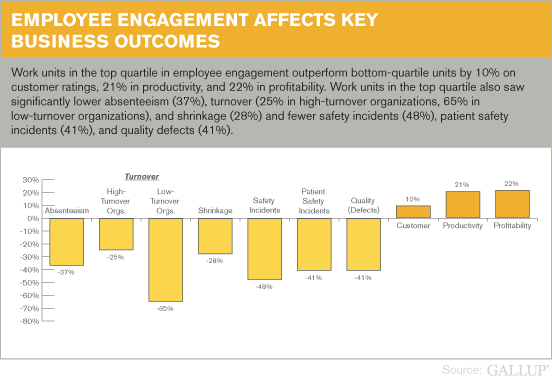123
Bp
Business performance data
Business performance data
Using the organisation’s financial results to monitor how communication efforts are aligning to the overall business objectives.
How Employee Engagement Drives Growth
The full and original article was published on Gallup
It’s great when companies try to improve employee engagement and even better when they measure it. Measurement is the first step companies must take before they can implement meaningful actions to improve engagement. But if they don’t measure the right things in the right way, those actions won’t matter — and they won’t have a measurable impact on business outcomes or the bottom line. Gallup researchers continually study findings to learn more about employee engagement and its impact on organizational and team performance.
Predicting key performance outcomes
Gallup researchers confirmed the well-established connection between employee engagement and nine performance outcomes:
- customer ratings
- profitability
- productivity
- turnover (for high-turnover and low-turnover organizations)
- safety incidents
- shrinkage (theft)
- absenteeism
- patient safety incidents
- quality (defects)
Research studied the differences in performance between engaged and actively disengaged work units and found that those scoring in the top half on employee engagement nearly doubled their odds of success compared with those in the bottom half. Those at the 99th percentile had four times the success rate of those at the first percentile. These kind of performance differences are always important to businesses.
Employee engagement affects key business outcomes
Work units in the top quartile in employee engagement outperformed bottom-quartile units confirming that employee engagement relates to each of the nine performance outcomes studied. Gallup also found that the strong correlations between engagement and performance are highly consistent across different organizations from diverse industries and regions of the world.

Increased engagement leads to higher earnings per share
Gallup’s research also shows that companies with engaged workforces have higher earnings per share (EPS), businesses with a critical mass of engaged employees outperformed their competition:
- Companies with an average of 9.3 engaged employees for every actively disengaged employee experienced 147% higher EPS compared with their competition
- Companies with an average of 2.6 engaged employees for every actively disengaged employee, in contrast, experienced 2% lower EPS compared with their competition during that same time period.
Researchers discovered that having an engaged workforce became a strong differentiator in EPS. Companies with engaged workforces seemed to have an advantage in regaining and growing EPS at a faster rate than their industry equivalents. Conversely, companies with average engagement levels saw no increased advantage over their competitors in economic instability.
Credit: The full and original article was published on Gallup
Thanks for stopping by!
Discovered, created or written something great that links to this element? Share links, articles, videos podcasts or infographics here.
Fill in your details and tick which resource you'd like to share.









